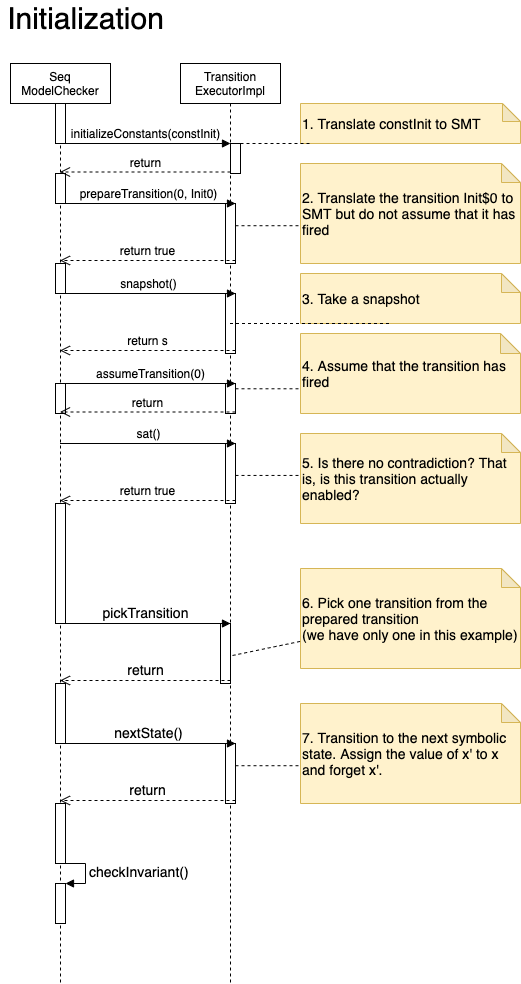ADR-003: transition executor (TRex)
| author | revision |
|---|---|
| Igor Konnov | 1 |
Transition executor is a new abstraction layer between the model checker and the translator of TLA+ expressions to SMT. The goal of this layer is to do the following:
- encapsulate the interaction with:
- the translator to SMT (called
SymbStateRewriter) - the SMT solver (accessed via
Z3SolverContext) - the type checker (accessed via
TypeFinder)
- the translator to SMT (called
- provide the model checker with an API for symbolic execution:
- independent of the assumptions about how satisfiability of TLA+ formulas is checked
- constraints can be added and removed incrementally, even if the background SMT solver is non-incremental (this is important as some constraints are better solved by incremental solvers and some constraints are better solved by offline solvers)
- the state of the symbolic execution (context) can be saved and restored on another machine (essential for a multicore or distributed model checker)
TRex can be thought of as an API for a satisfiability solver on top of TLA+ (in the fragment of KerA+). We can even say that TRex is a solver for TLA+, in contrast to an SMT solver, which is a solver for theories in first-order logic. As TLA+ is built around the concepts of a state and a transition, the TRex API abstracts symbolic execution in terms of symbolic states and symbolic transitions.
Classes
The figure below shows the class diagram of the essential classes
in TRex. TransitionExecutor provides the higher level (a model checker) with
an API for symbolic execution. TransitionExecutorImpl is the implementation
of TransitionExecutor. It maintains ExecutionContext that interacts with
the lower layer: the translator to SMT, the SMT solver, and the type checker.
Importantly, there are two implementations of ExecutionContext: an
incremental one (IncrementalExecutionContext) and an offline one
(OfflineExecutionContext). In contrast to the standard stack API of SMT
solvers (push/pop), ExecutionContext operates in terms of differential
snapshots. The implementation decides on how to translate differential
snapshots into interactions with the SMT solver.
IncrementalExecutionContext simply maintains the SMT context stack by calling
push and pop. When a snapshot must be taken, it simply returns the depth of
the context stack. Recovery from a snapshot is done by a sequence of calls to
pop. (IncrementalExecutionContext is not able to recover to an arbitrary
snapshot that is not subsumed by its current stack.) Thus,
IncrementalExecutionContext can be used for efficient interaction with an
incremental SMT solver on a single machine (even in a single thread, as Z3
contexts are not multithreaded).
OfflineExecutionContext records calls to SMT with the wrapper
RecordingZ3SolverContext. A snapshot produces an hierarchical log of calls to
SMT that can be replayed in another OfflineExecutionContext, even on another
machine.

Interaction with TransitionExecutor
We demonstrate a typical interaction with TransitionExecutor for the
following TLA+ specification, which has been preprocessed by the passes
preceding the model checker pass:
------------- MODULE Test -------------
EXTENDS Integers
CONSTANT N
VARIABLES x
ConstInit ==
N > 0
Init$0 ==
x = 10
Next$0 ==
x < 0 /\ x' = x + N
Next$1 ==
x >= 0 /\ x' = x - N
Inv ==
x >= 0
=======================================
The sequence diagram below shows how the sequential model checker translates
ConstInit to SMT and then translates Init$0.

The sequence diagram below shows how the sequential model checker translates
Next$0 and Next$1 to SMT. It first finds that Next$0 is disabled and
then it finds that Next$1 is enabled. The enabled transition is picked.

The sequence diagram below shows how the sequential model checker translates
~Inv to SMT and checks, whether there is a concrete state that witnesses
the negation of the invariant.

As you can see, TransitionExecutor is still offering a lot flexibility to the
model checker layer, while it is completely hiding the lower layer. We do not
explain how the parallel checker is working. This is a subject to another ADR.
To sum up, this layer is offering you a nice abstraction to write different model checking strategies.